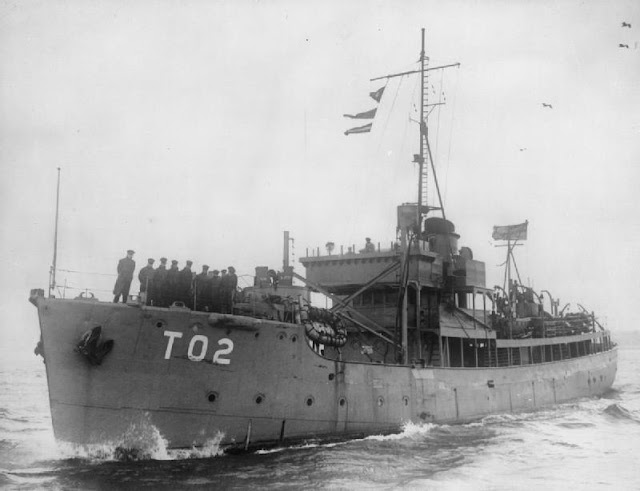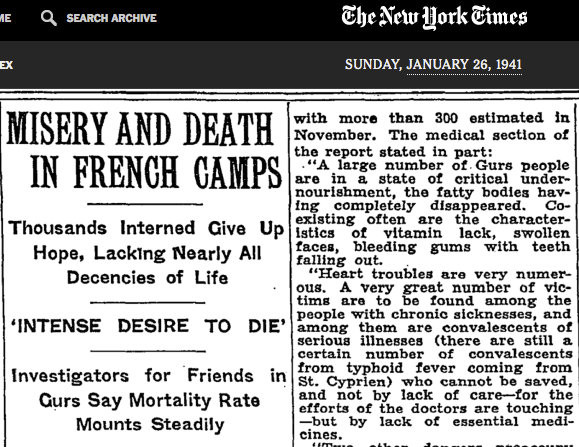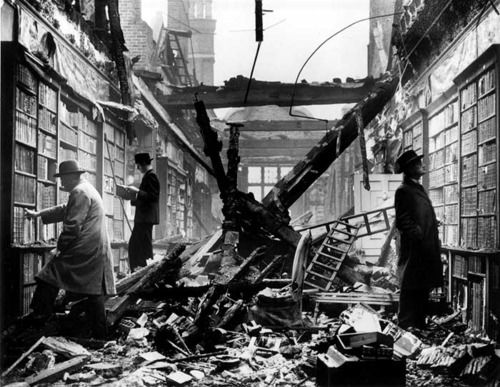Thursday 24 October 1940
The weather remains poor for flying, rainy and low-hanging clouds. However, this is an important day in the Battle of Britain because the Italians join in. They are based in Belgium, the zone of Luftflotte 2, and engage in operations with them against Harwich and Felixstowe after dark. The standard Italian fighter is a biplane long past its prime, and Italian bombers are 1930s tri-motor marvels that are, by late-1940 standards, lumbering and inadequately armed. Handled properly, though, they can be effective.
Italian General Corso Fougier has his Corpo Aereo Italiano (CAI, literally, "Italian Air Corps") HQ in Petite Espinette of Rhode-St-Genesis (between Brussels and Waterloo) and other operations are based at Evere airfield. The Italians operate under the command of II Fliegerkorps
 |
| Shown is the train bridge on Blackfriars Road between London Bridge and Waterloo Station, which, along with the trams beneath is, has sustained bomb damage. 24 October 1940). (London Fire Brigade). |
Around 14:30, the Luftwaffe sends across a small formation of Dornier Do 17s. They attack Hayes and damage the Farley Aviation Company.
As has been happening quite a bit lately, the weather causes some casualties. Two Hurricanes collide in the clouds near Taunton. One pilot is killed, the other plane, which only suffered damage to its tail, makes it back to base. The third Hurricane of No. 43 Squadron crashes upon landing due to fierce cross-winds, killing pilot Sgt. D.R. Stoodley. Another Hurricane of No. 303 Squadron crashes during dog-fight exercises.
After dark, the primary targets are London, Liverpool, and Manchester. The raids begin around 19:00 and come from all along the Channel coast. In London, New Street Station is engulfed in flames. Bombing accuracy in the iffy weather is poor, and bombs drop at random. The RAF somewhat charitably figures that the Luftwaffe was aiming for water mains and the like, and indeed there are some lucky hits. The Luftwaffe also continues mining the Thames Estuary and all along the eastern coastline.
The Italians send twelve BR.20Ms of 13o Stormo and six from 43o Stormo against Felixstowe and Harwich. They get off to a bad start when one of the bombers crashes shortly after takeoff near the church at Houtem, Belgium. Ten of the bombers make it to the target and drop their bombs, but two get lost on the way back and the crews have to bail out. A third bomber lands at the wrong airfield (Lille-Epinoy), damaging the aircraft. Only 8 of the 12 bombers sent off manage to return to their original base.
Losses for the day are low - assuming that you do not include the Italian bomber losses - at about 8 for the Luftwaffe and 4 for the RAF.
 |
| "A group of pilots of No. 303 Polish Fighter Squadron walking towards the camera from a Hawker Hurricane (probably Hurricane Mk.I, RF-F, V6684) after returning from a fighter sortie at RAF Leconfield, 24 October 1940. Left to right, in the front row are - Pilot Officer Mirosław "Ox" Ferić; Flight Lieutenant John A. Kent "Kentowski" (the CO of 'A' Flight); Flying Officer Bogdan Grzeszczak; Pilot Officer Jerzy Radomski; Pilot Officer Witold "Tolo" Łokuciewski; Pilot Officer Bogusław Mierzwa (obscured by Łokuciewski); Flying Officer Zdzisław Henneberg; Sergeant Jan Rogowski; Sergeant Eugeniusz Szaposznikow. In the center, to the rear of this group, wearing helmet and goggles is Pilot Officer Jan "Donald Duck" Zumbach." © IWM (CH 1535). |
After dark, the RAF launches the first attacks on Berlin which produce extensive civilian casualties. Other targets include oil installations at Hamburg, Hanover, and Gelsenkirchen; the ports of Hamburg, Bremerhaven, Cuxhaven, Wilhelmshaven, Rotterdam, Le Havre, and Lorient; and various airfields in northwest Europe.
Battle of the Atlantic: Things at sea continue to quiet down after the massive destruction recently visited upon Convoys SC 7, HX 79 and elsewhere. The U-boats are returning to port for re-stocking - but they will be back. It is this stage of the war - the "Happy Time - that the Kriegsmarine would most benefit from having more U-boats of ocean-going design.
In Operation DNU, Royal Navy destroyers HMS Matabele, HMS Punjabi and HMS Somali engage in a sweep off Norway. They are supported at a distance by the Home Fleet, represented by battlecruisers HMS Hood and Repulse and two cruisers. The destroyers sink German weather ship WBS 5 Adolf Vinnen (a 391-ton trawler) off Stadtlandet, Norway (north of Bergen) (some accounts state that accompanying submarine HMS Seawolf actually sank the weather ship). The destroyers attempt to intercept a group of 20 fishing vessels escorted by one ship nearby but make no contact. After this, the destroyers and supporting battlecruisers head back to Scapa Flow. It is an unproductive operation not worth the fuel and time; the Admiralty must have thought something more important was happening off Norway. Kriegsmarine battlecruiser Admiral Scheer is heading that way and may have been the real target, but it has not yet left German waters.
Royal Navy destroyer HMS Mendip is sailing just off Barrel of Butter when it accidentally sets off one of its own depth charges. This blows the stern of the ship off and it must be towed to Scapa Flow. The repairs, made at the Tyne, will take until February 1941.
German 3664 ton freighter Helgoland departs from Puerto Columbia, Colombia in a risky bid to return to a French Atlantic port of St. Nazaire. Not only must it evade the Royal Navy, but also patrolling US destroyers who typically make sure that the Royal Navy is informed of their whereabouts. The journey will pass by St. Thomas on its way toward the Atlantic. The US destroyers are alerted to its departure and give chase.
Convoys OA 234 (last of this OA series) and Convoy FS 319 depart from Methil, Convoy OB 234 departs from Liverpool, Convoy FN 318 departs from Southend, Convoy HX 83 departs from Halifax, Convoy SC 9 departs from St John.
 |
| RAF ground crew preparing a bomb to be used against Italian positions in North Africa, 24 October 1940. |
In Malta, there is an air raid alert around noontime. As they often do, however, the Italian raiders stay far off the coast, circle for a while, then return to base. It is a curious routine, perhaps the pilots are not interested in actually attacking the island but want to make it look like they did to their superiors. The citizenry on the island shows increasing signs of anti-Italian sentiment, with many wishing to change street names and accusing neighbors of being secret Italian sympathizers. The sight of Italian POWs also sets off many residents.
German/French Relations: Following his unproductive meeting with Franco at the Spanish border, Hitler travels to Montoire-sur-le-Loir and meets with Marshal Philippe Pétain. This location is both convenient to the main railway line from Berlin-Paris-Hendaye but also has a tunnel nearby in case of an air attack. That railway tunnel, in fact, has steel doors affixed to it for this meeting that still remain in the 21st Century.
Hitler is on much more solid footing with Petain than with Franco, but things do not go particularly well in this meeting. Yes, Petain does state that he is willing "to collaborate," but those are just words that must be fleshed out with substance to have any real consequences. As in his meetings with Mussolini and other leaders, Hitler engages in long monologues while Petain says little. Petain says nothing that could be considered sympathetic to Germany. At the end of the meeting, Petain takes out a list of French demands for collaboration and sticks it in Hitler's pocket.
The most important thing that happens at the meeting is that Petain says "no" when Hitler asks him to join the war against England. This is usually what the French take away from this meeting, that Petain "said no to Hitler." However, to the Allies, collaborating alongside the Germans was almost as bad. French resources prove immensely valuable to the Reich's war effort from this point forward.
There is also a feeling among some that Petain "stared Hitler down." The story goes that Petain's advisor, Rene Gillouin, had told Hitler to stare at him unflinchingly. This very basic trick supposedly unnerves Hitler. It is fair to say that modern French opinion about Petain is overwhelmingly negative, but there is an undercurrent of pride in the way he handled this meeting.
An interesting outcome in this meeting is in the way that Petain describes it a week later in a radio broadcast. On 30 October, he refers to "the new European order," a phrase that resonates with one Ribbentrop has been using in secret communications with the Soviet Union (though there he uses "New World Order"). In that speech, Petain also states that he will "enter today the path of collaboration." While Montoire is not the start of a new war for France, it is the beginning of the long, dark collaborationist journey that blackens the name of the Vichy regime. In that sense, the meeting constitutes an overwhelming success for Hitler.
US/French Relations: The US State Department cautions the Vichy government not to permit the Germans to use French warships.
 |
| Arming one of the bombers heading to Berlin. 24 October 1940 (AP Photo). |
The Italians hint darkly that Petain and de Gaulle are actually in cahoots to hoodwink Hitler and demand numerous territorial and economic demands to be imposed upon France, including her overseas colonies. Basically, Spain and Italy now both want to dismember France to their own benefit - or, put more accurately, they want Hitler to do it for them.
Having, at last, realized that Italy - or at least Mussolini - is acting like a spurned lover over the German wooing of Spain and France, German Foreign Minister Ribbentrop (traveling with Hitler in his own separate train) springs into belated action. Ribbentrop calls his Italian counterpart, Count Ciano, during the evening. The call does not go well - Ciano conveys his "fears and suspicions" that Germany is about to sell out its staunch ally Italy in favor of the French and Spanish floozies. Ribbentrop immediately drafts a letter which summarizes the current situation:
- The talks with Spain had failed;
- France was willing to cooperate with Germany (how far he does not explain, and in fact that remains an open question);
- Hitler would soon send Mussolini a letter of his own summarizing matters and would like to set up another meeting with Mussolini ASAP in northern Italy.
US Military: Heavy cruiser USS Louisville departs from Rio de Janeiro for Montevideo, Uruguay as part of its "Show the Flag" mission.
Lighter cruiser St. Louis arrives at Hamilton, Bermuda with the members of the Greenslade Board who are inspecting British bases acquired in the destroyers-for-bases deal.
Belgium: Taking a much different route than France, Belgium opens a government-in-exile in London. It is led by Hubert Pierlot and Paul-Henri-Spaak, who only recently escaped from detention in Francoist France, and Camille Gutt. The new government quickly declares war on Italy for operating air missions from Belgian airfields.
British Homefront: The recent call to outlying cities to supply buses to London produces its first results. The first provincial buses appear on London streets. Driving in London is increasingly dangerous due to the deteriorating streets and the continued need for the blackout. You never know when a recent bomb hit may have left some debris in the road, and that is tough to see in the dark. Ultimately, about 2000 buses will go into service to keep the capital functioning.
Unlike in 1939, the government decides to extend British Summer Time throughout the winter.
American Homefront: The Fair Labor Standards Act of 1938’s mandate of a 40-hour workweek with time-and-a-half overtime pay for hours of work beyond that takes effect. The same basic scheme has been in place ever since.
October 1940
October 2, 1940: Hitler's Polish Plans
October 3, 1940: British Cabinet Shakeup
October 4, 1940: Brenner Pass Meeting
October 5, 1940: Mussolini Alters Strategy
October 6, 1940: Iron Guard Marches
October 7, 1940: McCollum Memo
October 8, 1940: Germans in Romania
October 9, 1940: John Lennon Arrives
October 10, 1940: Führer-Sofortprogramm
October 11, 1940: E-Boats Attack!
October 12, 1940: Sealion Cancelled
October 13, 1940: New World Order
October 14, 1940: Balham Tragedy
October 15, 1940: Mussolini Targets Greece
October 16, 1940: Japanese Seek Oil
October 17, 1940: RAF Shakeup
October 18, 1940: Convoy SC-7 Catastrophe
October 19, 1940: Convoy HX-79 Catastrophe
October 20, 1940: Convoy OB-229 Disaster
October 21, 1940: This Evil Man Hitler
October 22, 1940: Aktion Wagner-Burckel
October 23, 1940: Hitler at Hendaye
October 24, 1940: Hitler and Petain
October 25, 1940: Petain Woos Churchill
October 26, 1940: Empress of Britain Attack
October 27, 1940: Greece Rejects Italian Demands
October 28, 1940: Oxi Day
October 29, 1940: US Draft Begins
October 30, 1940: RAF Area Bombing Authorized
October 31, 1940: End of Battle of Britain
2020








